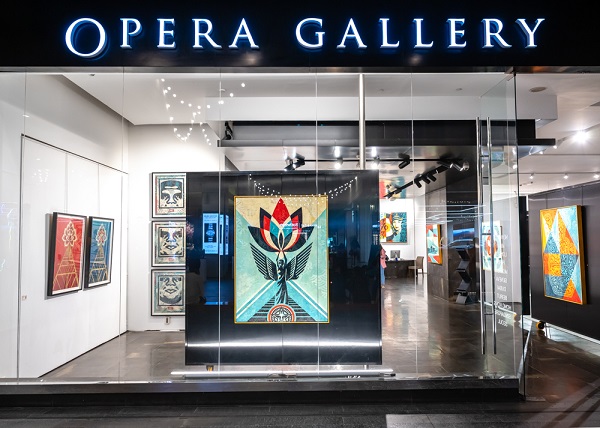As a commentor on the contemporary art market I am against commodification of our life and of art as embodiment of it, but it was interesting to research these iconic women artists and discuss their financial success. If Kusama has consistently been represented among the best sold artists some names Natalia Goncharova or Agnes Martin are newer and it’s encouraging to see them on the list. Analysis provided is more cultural than financial as I am more into culture than finance. All five women were striking, with iconic life stories, they are muses, role models, patron saints, and iconoclasts. On the one hand it seems they are finally getting their dues. Yet, on the other hand their works still represent a minority among blue chip lots of Christie’s and Sotheby’s.
Yayoi Kusama

There is no other artist more associated with the commodified art and IG-oriented works than Yayoi Kusama (b.1929). What is it that fascinates people of all ages and countries with Kusama? In the Freudian tradition her works do remind us of over-the-top child at play, a child who was given a free reign by a commodified society to create anything she desires. Her constructed image is equally fascinating and tame through its exaggerated irregularity. Her color contrasts are never unpleasant, and the universal intrinsic satisfaction of its shapes is primal. Yet, her story is a story of mental suffering giving it a human angle, an element to relate to. But to guard off cynicism, it is important to remember the thorny, now forgotten, path Kusama went through. In 1960s Kusama got the public attention for the first time through happenings foregrounding questions of gender, sexuality, minorities, body, discrimination, repression and the Vietnam war. As other performance and installation artists of this period Kusama tried to subvert the status quo through non-traditional art forms, participating the protest culture of the day. It is also important to remember how the artist was largely forgotten until her first major retrospective at the Center for International Contemporary Arts (CICA) in New York in 1989. This led to an important exhibition at the Museum of Modern Art in 1998.
Among the highest sold works by Kusama are: The “White No.28 of 1960” was the highest sold piece $7 million in 2014 via Christie’s New York. 2 In 2021 through the fall sales at Christie’s, Sotheby’s and Phillips Kusama’s works fetched $7.1 million across 5 different sales. 3 She is the most popular artist in terms of museum attendance. In 2019 her exhibition “Infinity Mirrors” at the Cleveland Museum of the Art was attended by 120,000 people.
Agnes Martin

ARTISTS RIGHTS SOCIETY (ARS), NEW YORK. PHOTO: BILL JACOBSON STUDIO, NEW YORK.
Agnes Martin (1912-2004) is one of the divisive names for art aficionados. Some people do not see anything in her mostly monochromatic works, others see everything in them. By everything I mean that people do see universes, stars, forests, molecules, or infinite blankets of lines. In contrast to Kusama, Martin stands on the opposite side of the spectrum, too white and minimal and bland for some. Martin grew up on a farm, later moving with her family to Vancouver and then to the U.S in 1931 to get her fine art and art education degree at various schools culminating in studying at Teachers College, Columbia University. 1952 Martin was heavily influenced by newly introduced Buddhism and meditation, prompted by her beliefs to move to a remote township of Taos, New Mexico where she meditated and changed her approach to figuration in art.
Important New York art dealer, Betty Parsons, while representing Mark Rothko and Barnett Newman was very impressed by Martin’s work after seeing it in Taos and proposed the artist a move to New York. Martin remained here until 1967 when she sold all her possessions and travelled across the U.S. and Canada in her camper van. Martin suffered from schizophrenia in her adult life, writing honestly about in “The Untroubled Life.” There is also a very telling passage about her approach: “The empty form goes all the way to heaven. It is the classic form – lighter weight. My work is anti-nature the four-story mountain mountain. You will not think from, space, line, countour.” 5 During her move Martin quit painting, returning to it in five years. Martin had her first retrospective at the Institute of Contemporary Art in Philadelphia in 1973.
In 2016 her work Orange Grove sold for $10.7 million at Christie’s. One of the highest sold artworks by Martin is Untitled #44 auctioned in November 2021 at $17.7 million during the famed Macklowe Collection sale at the Sotheby’s, setting a new record for the artist at an auction.
Frida Kahlo

As Yayoi Kusama, Vincent Van Gogh and August Renoir, Frida became one of those ubiquitous names that stand for much more than their art. These names stand also for all the products licensed in their name, for all the profits museums and souvenir shops make on these names so much so that they have lost the value, the connection with the sublimity of the works they have once created, of their works that once were revolutionary. Ironically, the Frida Kahlo Foundation deludes her legacy through all the licenses it is issuing. 8 Devaluation of the artist because of her name is inevitable in the era of when copy numerically surpasses the original to allude to Walter Benjamin. It is hardly fair, but inevitable, when NFTs and Metaverse is our collective future. “Is an author of a copy, an author? If “author” is defined as an exceptional and unique individual, able to express him/herself in a way no one else can, then only an author could produce the unique and exceptional work we call an original. The maker of a copy could not be an author. Furthermore, in a copy we still see only the original and its author, while the maker of the copy completely disappears.” 9 But in Frida’s case somehow the creator or the seller of the copy is visible, we still associate the souvenirs with the place they come from and where we spent such-and-such time. But one can only imagine what will happen to Frida’s self- portraits when presented in NFTs, how far they will be removed from the original.
Another important element that makes Frida’s works relatable, beyond theatrically staged self- portraits and compassion we feel to her pain and painful marriage are the factors of post-colonialism, class, race, gender, addiction, identity, trauma, and intimacy. All are elements of her story that talk to us as women. But also, her involvement with the Communist politics as well as support of the movement for the Mexican independence. Multi-dimensional life and personality of this woman is discarded through the way of her commodification.
Apparently, her story speaks to the collectors. In November 2021 Frida’s self-portrait sold for $34.9 million at Sotheby’s, becoming the highest ever paid at an auction work of Latin American artist. It is very ironic that through this sale Kahlo’s painting got far ahead of Diego Rivera’s price ($10.75 million) for the highest sold Latin American artworks fetched in 2018.
Natalia Goncharova

Trailblazer of the Russian avant-garde Natalia Goncharova (1881-1962) is probably the least known to the mass audience, yet, her name is indispensable for understanding of XX century history of theater and painting. Goncharova was painter, sculptor, graphic and performance artist, book illustrator, stage set and costume designer and she has left an indelible mark in all these disciplines. Goncharova’s life was split in two when during her trip to France in 1917 the Russian revolution took place, forever preventing the artist’s return back to Moscow. Her name is tightly connected to her brilliant partner and husband — artist and theoretician Mikhail Larionov (1881-1964). Father of Luchism and a bright talent, Larionov, influenced Goncharova, but she also stood her ground through an incredible inventiveness and attunement to plastic forms, tirelessly investigating her preoccupation with volume, color, expressionism and abstraction. During her first exhibition in 1913 in Moscow Goncharova presented more then 700 works she has completed over ten years of study and immersion in revolutionary and rebellious atmosphere of the time. Larionov and Goncharova spearheaded radical art groups such Jack of Diamonds and Donkey’s Tale. The latter included such renowned names today as Kazimir Malevich and Marc Chagall. Cubo-futurism was one the direction that this group pursued, but for Goncharova personally theory followed the art and not the other way around. This spontaneity and fluidity are visible in her paintings as they transcended any given movement or theory, she was formally part of. After introduction to the genius impresario of Ballets Russes Sergei Diaghilev Goncharova started to paint decorations for his spectacular productions in Paris. It was the reason for Goncharova’s trip to Paris that was to last the remainder of her life.
Goncharova was exhibited at various points including 1961 large duo presentation of Goncharova and Larionov in London, 1962 first posthumous solo show at the Museum of Modern Art in Paris. Over time her works rose in status becoming most expensive artworks by women artists sold at prestigious auction houses. In 2007 her Apple Harvest was sold for record-setting £4.9 million at Christie’s, in 2008 Les Fleurs (1912) was sold for just over $10.8 million. She has been presented to the world via important exhibitions in Moscow (2013), Tate (2019) and continues to garner global interest as one of the Amazons of the Russian avant-garde.
What draws this interest? In a way, it probably is a nostalgia for a liberal time in XX century when anything seemed possible. When bright talents with whom Goncharova worked throughout her life were experimenting, creating new theories and forms of art, were fighting over their theories and vehemently trying to implement them in life. But part of Goncharova’s appeal is her exuberant energy we see flowing even today and through her copious legacy.
Louise Bourgeois

Upon her death on the 31 st of May 2010, Louise Bourgeois was eulogized by the New York Times as an artist whose work “shared a set of repeated themes, centered on the human body and its need for nurture and protection in a frightening world.” Bourgeois as an artist incorporated her life into her work; from a childhood filled with anxieties and tensions to migrating and settling in a new country while trying to succeed as an artist at a time where many believed “women can’t paint, women can’t write” to quote Virginia Woolf. Bourgeois is therefore an embodiment of tenacity articulated through art that is bold and honest in deconstructing stereotypes about being a female artist and expressing the feminine.
Although earlier in her career the artist attempted to mute focus on the feminist ideals suggested by her work, its symbolic connotations cannot be ignored as evident in the imagery of the spider and naked torsos to name just two. Family and the feminine are two sources of inspiration for the artist which deserves some investigation especially in relation to their figurative and symbolic significance. The eclectic nature of the art itself also contributes in making her ever relevant.
In 2019 Bourgeois’ Spider (1996) sold for $32 million at Christie’s, thus becoming the most expensive sculpture by a contemporary female artist. The market for her works started to develop after 1982 retrospective at New York Museum of Modern Art, after this exhibition the artist was able to move onto large-scale bronze sculptures. Apparently, Bourgeois collectors hunt most avidly after her spiders.
It is inspiring to see that besides these five names there are others that are becoming better known to the wider audience. Mickalene Thomas, Nina Chanel Abney as well as Georgia O’Keefe, Alice Neel, Tamara de Lempicka are the women whose names now do resonate through the years and the collectors. Let’s hope this appreciation will continue and grow in numbers.

For more updates on the latest art news and events, visit: @arte8lusso on Instagram.



